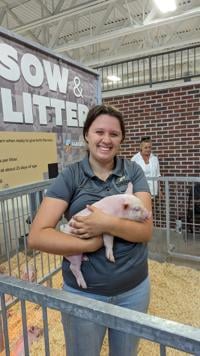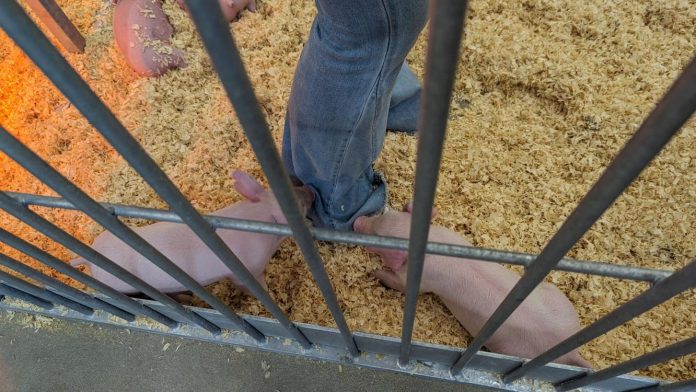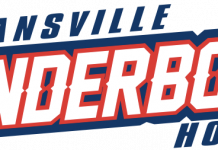By Kayla Barlow, TheStatehouseFile.com
In the Indiana State Fair’s swine building, pale pink piglets gleefully prance about, play fight, and burrow in the hay in their pen while their mild-mannered mother, a pig named Jenny, looks on.
Curious, the pigs decide to nibble on an unlikely snack—the fringe of an intern’s jeans.
Intern Claire Mauer stands inside the hay-littered pen with the pigs. For the chipper brunette, who wears a collared gray Purdue animal sciences shirt, their munching habits are just part of the job.
As a junior animal science major pursuing a concentration in agricultural business, being around livestock is something she enjoys.
“I love working with the animals, it’s great,†Claire said.

While she’s always been interested in agriculture, the Indianapolis native wasn’t around animals for the majority of her life.
“I had no large animal experience, and that’s why I took this internship—to get experience,†she said. “It’s been really cool just being able to, you know, see the stuff we learned in class, seeing it applied onto the actual, like, job field … [to] see the different cycles, the different phases of the ages and see truly how fast they grow.â€
Through the internship, Claire has been able to work with a myriad of animals, such as sheep, goats, horses, turkeys and llamas. She also greatly enjoys working with fairgoers who stop by the pigpen.
“I love working with people. Being able to talk and educate, that is what I was super excited about for this part of the internship—not only learning new stuff myself but being able to go out and teach people who have never had experience with animals,†Claire said.
The education Claire provides is something she holds as important, and for good reason.
“I think it’s so easy to, you know, grow away from our production because that’s namely what, you know, we produce for, it’s for food production,†Claire said. “And it’s amazing when you talk to people and they don’t know where their food comes from. They don’t, you know, know how it’s raised or how it’s grown.â€
The knowledge she’s gained is something that she hopes to impart on all those who stop by the pen at the fair.
“I think it’s really, really important for people to still be able to see, like, ‘Hey, this is still a huge part of our society, still a huge part of our lives,’ even if it’s something that people aren’t seeing from day to day.â€





